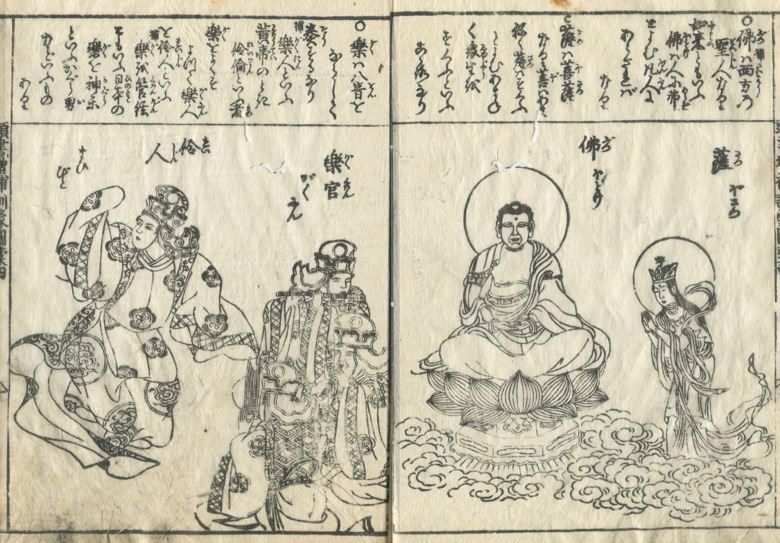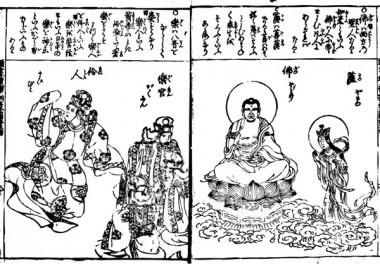A bodhisattva and the Buddha are drawn on the right.
It is said that “佛 (Butu/Hotoke)” also calls it “Buddha” as a Saint in the direction of west.
佛 reads saying “is not a person”, and it means not being an ordinary man (ordinary human being).
” 薩 (Satu)” was not able to translate a meaning, although the “bodhisattva” was written to be “薩 which invites 菩.”
The Buddha and the bodhisattva who carried the aureole on the back with the picture are drawn, and expression of clouds is an image of Tang.
The player of the musical instrument is drawn on the left.
“comfort accustoms and plays eight sound in the text, and tells a “musician” to it.
The person “伶倫 (reirin)” was near “黄帝 (koutei : monarch on a Chinese tradition)”, and it was called “楽 (gaku).”
Moreover, a “musician” is also called “伶人 (reijin).”
“Gaku” also calls it “wind and stringed instruments”, and “Gaku” of Japan is called “Kagura court dance and music”. It is written as “.
“楽官 (gakukan)” which plays a whistle, and “Reijin” who dance are drawn on the picture.
右には菩薩と仏が描かれています。「佛(ぶつ/ほとけ)」は、西の方の聖人として「如来(にょらい)」ともいうそうです。佛は「人に弗(あらざる)」と読み、凡人(普通の人間)ではないことを意味しています。「薩(さつ)」は「菩薩(ぼさつ)」は「菩を招く薩」と書かれていますが、意味を訳せませんでした。絵では光輪を背負った仏と菩薩が描かれており、雲の表現は唐のイメージです。
左には楽器の演奏者が描かれています。本文には、『楽は八音をならして奏で、「楽人(がくにん)」という。「黄帝(こうてい:中国の伝説上の帝王)」のそばには「伶倫(れいりん)」という者がいて、「楽(がく)」と呼ばれていた。また、「楽人」は「伶人(れいじん)」とも呼ばれる。「楽」は「管弦」ともいい、日本(ひのもと)の「楽」を「神楽(かぐら)」という。』と書かれています。絵には笛を奏でる「楽官(がくかん)」と舞いを舞う「伶人(れいじん)」が描かれています。

